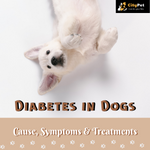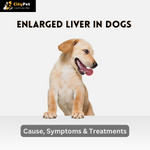Hair Loss in Dogs: Causes, Symptoms & Treatments
Hair loss in dogs, also known as alopecia, is the loss of hair from areas of a dog’s body where hair would normally grow. It can be caused by a variety of factors, including parasites, allergies, infections, hormonal imbalances, stress, and poor nutrition.
Symptoms of hair loss in dogs can include bald patches, thin or patchy coats, excessive shedding, scratching or itching, redness or inflammation, dandruff or scaly skin, and changes in skin color or texture.
To diagnose hair loss in dogs, a veterinarian may perform a physical exam, take a thorough medical history, and perform diagnostic tests such as skin scrapings, blood tests, allergy testing, and biopsies.
Hair loss in dogs can be a stressful experience for both the pet and their owner. In this blog post, we’ll cover some of the common symptoms, causes, and treatments of hair loss so you know how to best help your pup. We’ll also discuss potential solutions that may help regrow lost fur and reduce shedding.
Causes of Hair Fall in Dogs
Hair fall or shedding in dogs is a natural process that helps to get rid of old or damaged hair and make room for new hair growth. However, excessive hair loss can be a sign of an underlying health problem. Here are some common causes of hair fall in dogs:
- Seasonal shedding: Dogs often shed their hair in response to seasonal changes in temperature and daylight hours.
- Poor nutrition: A poor diet can lead to poor coat quality and excessive shedding. Nutrient deficiencies, especially in omega-3 fatty acids, can also contribute to hair fall.
- Allergies: Dogs can develop allergies to certain foods, medications, or environmental allergens, such as pollen or dust mites. Allergies can cause skin irritation and hair loss.
- Parasites: Fleas, ticks, and mites can irritate a dog’s skin and lead to excessive scratching, which can result in hair loss.
- Hormonal imbalances: Hormonal imbalances, such as hypothyroidism or Cushing’s disease, can affect a dog’s coat and lead to hair loss.
- Stress: Stressful events, such as a move, the arrival of a new pet or baby, or a change in routine, can cause a dog to shed more than usual.
- Infections: Bacterial, fungal, or yeast infections of the skin can cause hair loss.
If you notice excessive hair loss in your dog, it’s important to take them to the vet to rule out any underlying health problems and develop an appropriate treatment plan.
Symptoms of Hair Loss in Dogs
Symptoms of hair loss in dogs can vary depending on the underlying cause of the condition. Here are some common signs of hair loss in dogs:
- Bald patches: If you notice circular or irregular areas of hair loss, it may be a sign of a fungal or bacterial infection.
- Thin or patchy coat: If your dog’s coat appears thin or patchy, it could be due to seasonal shedding or nutritional deficiencies.
- Excessive shedding: If your dog is shedding more than usual, it could be a sign of an underlying health problem.
- Scratching or itching: Dogs that are constantly scratching or biting their skin may be experiencing skin irritation, which can cause hair loss.
- Redness or inflammation: Inflamed or red skin around the hair loss area may indicate an infection or allergy.
- Dandruff or scaly skin: Dandruff or scaly skin can be a sign of a skin infection or nutritional deficiencies.
- Changes in skin color or texture: Changes in skin color or texture, such as thickening or darkening of the skin, can be a sign of hormonal imbalances or skin infections.
If you notice any of these symptoms in your dog, it’s important to take them to the vet for a proper diagnosis and treatment. Early intervention can help prevent further hair loss and underlying health problems.
Treatments for Hair Loss in Dogs
The treatment for hair loss in dogs depends on the underlying cause of the condition. Here are some common treatments for hair loss in dogs:
- Parasite control: If hair loss is caused by a parasite infestation, such as fleas or mites, treating the infestation with appropriate medication can help stop hair loss.
- Nutrition: Ensuring your dog is on a well-balanced diet with sufficient nutrients, including protein, vitamins, and minerals, can improve coat health and reduce hair loss.
- Medications: Certain medications may be prescribed to treat hormonal imbalances, allergies, or infections that can cause hair loss.
- Topical treatments: Topical treatments, such as medicated shampoos or ointments, can be used to treat skin infections and promote hair growth.
- Allergy testing and immunotherapy: If hair loss is caused by allergies, testing can be done to identify the allergen and then immunotherapy can be used to help your dog build immunity to the allergen.
- Stress reduction: Reducing stress in your dog’s environment can help prevent hair loss due to stress.
It’s important to take your dog to the vet for a proper diagnosis and treatment plan. Untreated hair loss can lead to further health problems, and early intervention can help prevent further hair loss and promote hair regrowth.
Diagnose Hair Loss in Dogs
To diagnose hair loss in dogs, a veterinarian will typically perform a physical exam, take a thorough medical history, and may perform some diagnostic tests. Here are some common methods of diagnosing hair loss in dogs:
- Skin scrapings: Skin scrapings can help diagnose bacterial, fungal, or parasitic infections that can cause hair loss.
- Blood tests: Blood tests can help detect hormonal imbalances, such as hypothyroidism or Cushing’s disease, which can cause hair loss.
- Allergy testing: Allergy testing can help identify the allergen causing skin irritation and hair loss.
- Biopsy: In some cases, a biopsy may be taken of the affected area to help identify the underlying cause of hair loss.
- Visual examination: A veterinarian may visually examine the skin and coat for signs of parasites, skin infections, or other conditions that can cause hair loss.
- Diet evaluation: A veterinarian may evaluate your dog’s diet to determine if any nutritional deficiencies could be contributing to hair loss.
By using one or more of these diagnostic methods, a veterinarian can identify the underlying cause of hair loss in your dog and develop a treatment plan to address the specific condition.
Prevent Hair loss in Dogs
Preventing hair loss in dogs involves taking steps to maintain their overall health and addressing any underlying conditions that can contribute to hair loss. Here are some ways to prevent hair loss in dogs:
- Regular grooming: Regular grooming can help remove loose hair and prevent matting, which can lead to hair loss.
- Good nutrition: Feeding your dog a well-balanced diet with appropriate amounts of protein, vitamins, and minerals can help maintain healthy skin and coat.
- Parasite prevention: Regular use of flea and tick prevention can help prevent infestations that can lead to skin irritation and hair loss.
- Stress reduction: Reducing stress in your dog’s environment can help prevent hair loss due to stress.
- Regular vet check-ups: Regular check-ups with a veterinarian can help detect and treat any underlying health conditions that can contribute to hair loss.
- Proper hygiene: Keeping your dog clean and dry, especially after swimming or being outside in wet weather, can help prevent skin infections that can lead to hair loss.
By following these preventative measures, you can help your dog maintain a healthy coat and prevent hair loss. It’s important to take your dog to the vet for regular check-ups to detect any potential health problems early on.
































